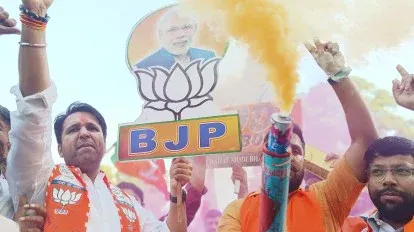
Date: October 08, 2024
Election Results: BJP Shines in Haryana, Faces Setback in J&K
Overview of Election Results
The election results from Haryana and Jammu & Kashmir have brought significant developments, revealing contrasting fortunes for the BJP. With the final rounds of counting underway, the BJP is poised to celebrate a remarkable victory in Haryana while experiencing disappointment in Jammu & Kashmir.
BJP’s Triumph in Haryana
As per the latest updates from the Election Commission, the BJP is leading in 50 seats in Haryana, while the Congress party has secured 35 seats. The total number of seats in the Haryana assembly is 90, with a magic number of 46 required to form the government. This gives the BJP a narrow lead and positions them to establish a government for the third consecutive time.
The BJP’s strong performance in Haryana comes as a surprise, especially considering that most major exit polls had predicted a Congress victory. Early trends also hinted at a Congress win, but the BJP managed to execute a remarkable turnaround, capturing 50 seats and solidifying its status as the favorite to complete a hat-trick of wins in the state. This shift highlights the dynamic nature of electoral politics in Haryana and the party’s ability to rally support despite initial setbacks.
Jammu & Kashmir’s Political Landscape
In contrast, the situation in Jammu and Kashmir tells a different story. The JK National Conference, led by Farooq Abdullah, is leading in 42 seats, while the BJP trails behind with 29 seats. This outcome is consistent with expectations, as the National Conference, along with support from their ally Congress, is on track to form the government in Jammu and Kashmir. The political landscape here has remained stable, with the National Conference maintaining its influence in the region.
Implications of the Election Results
The election results from both states underline the complexities of regional politics in India. The BJP’s stronghold in Haryana reflects the party’s sustained popularity and strategic campaigning efforts, while its challenges in Jammu and Kashmir signify the need for renewed focus and engagement in the region.
These outcomes will have far-reaching implications for both parties as they prepare for future elections and navigate the ever-changing political landscape. The BJP’s success in Haryana could serve as a model for its strategies in other states, while the National Conference’s resurgence in Jammu and Kashmir may reignite discussions on regional governance and political alliances.
Conclusion
The electoral results reveal a fascinating juxtaposition between the BJP’s triumph in Haryana and its struggles in Jammu and Kashmir. As the party celebrates its achievements, it must also reevaluate its strategies in regions where it faces challenges. The coming months will be crucial as both the BJP and Congress seek to consolidate their positions in these key states.